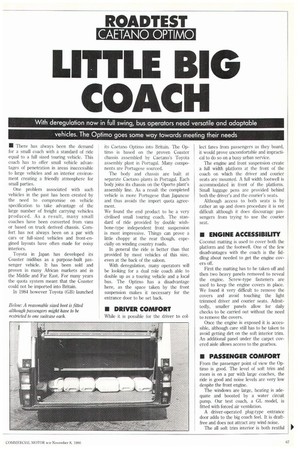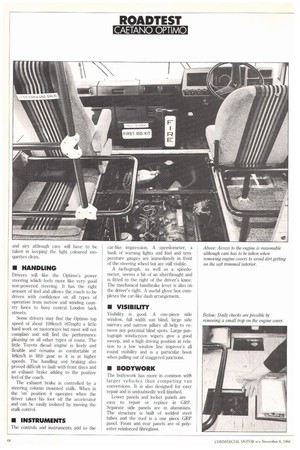LITTLE BIG COACH
Page 69

Page 70

Page 71

If you've noticed an error in this article please click here to report it so we can fix it.
With deregulation now in full swing, bus operators need versatile and adaptable vehicles. The Optimo goes some way towards meeting their needs
• There has always been the demand for a small coach with a standard of ride equal to a full sized touring vehicle. This coach has to offer small vehicle advantages of penetration in areas inaccessible to large vehicles and an interior environment creating a friendly atmosphere for small parties.
One problem associated with such vehicles in the past has been created by the need to compromise on vehicle specification to take advantage of the large number of freight carrying vehicles produced. As a result, many small coaches have been converted from vans or based on truck derived chassis. Comfort has not always been on a par with cars or full-sized vehicles and front-engined layouts have often made for noisy interiors.
Toyota in Japan has developed its Coaster midibus as a purpose-built passenger vehicle. It has been sold and proven in many African markets and in the Middle and Far East. For many years the quota system meant that the Coaster could not be imported into Britain.
In 1984 however Toyota (GB) launched its Caetano Optimo into Britain. The Optimo is based on the proven Coaster chassis assembled by Caetanc)'s Toyota assembly plant in Portugal. Many components are Portugese sourced.
The body and chassis are built at separate Caetano plants in Portugal. Each body joins its chassis on the Oporto plant's assembly line. As a result the completed vehicle is more Portugese than Japanese and thus avoids the import quota agreement.
We found the end product to be a very civilised small touring coach. The standard of ride provided by double wishbone-type independent front suspension is most impressive. Things can prove a little choppy at the rear though, especially on winding country roads.
In general the ride is better than that provided by most vehicles of this size, even at the back of the saloon.
With deregulation, many operators will be looking for a dual role coach able to double up as a touring vehicle and a local bus. The Optimo has a disadvantage here, as the space taken by the front suspension makes it necessary for the entrance door to be set back.
II DRIVER COMFORT
While it is possible for the driver to col lect fares from passengers as they board, it would prove uncomfortable and impractical to do so on a busy urban service.
The engine and front suspension create a full width platform at the front of the coach on which the driver and courier seats are mounted. A full width footvvell is accommodated in front of the platform, Small luggage pens are provided behind both the driver's and the courier's seats.
Although access to both seats is by rather an up and down procedure it is not difficult although it does discourage passengers from trying to use the courier seat.
• ENGINE ACCESSIBILITY
Coconut matting is used to cover both the platform and the footwell. One of the few disadvantages with the coach is the fiddling about needed to get the engine covers off.
First the matting has to be taken off and then two heavy panels removed to reveal the engine. Screw-type fasteners are used to keep the engine covers in place. We found it very difficult to remove the covers and avoid touching the light trimmed driver and courier seats. Admittedly, smaller panels allow for daily checks to be carried out without the need to remove the covers.
Once the engine is exposed it is accessible, although care still has to be taken to avoid getting dirt on the soft interior trim. An additional panel under the carpet covered aisle allows access to the gearbox.
• PASSENGER COMFORT
From the passenger point of view the Optimo is good. The level of soft trim and room is on a par with large coaches, the ride is good and noise levels are very low despite the front engine.
The windows are large, heating is adequate and boosted by a water circuit pump. Our test coach, a GL model, is fitted with forced air ventilation.
A driver-operated plug-type entrance door adds to the big coach feel. It is draftfree and does not attract any wind noise.
The all soft trim interior is both restful
and airy although care will have to be taken in keeping the light coloured moquettes clean.
• HANDLING
Drivers will like the Optimo's power steering which feels more like very good non-powered steering. It has the right amount of feel and allows the coach to be driven with confidence on all types of operation from narrow and winding country lanes to busy central London back streets.
Some drivers may find the Optimo top speed of about 1.08km/h (67mph) a little hard work on motorways but most will not complain and will find the performance pleasing on all other types of route. The little Toyota diesel engine is lively and flexible and remains as comfortable at 481cm/h in fifth gear as it is at higher speeds. The handling and braking also proved difficult to fault with front discs and an exhaust brake adding to the positive feel of the coach.
The exhaust brake is controlled by a steering column mounted stalk. When in the 'on' position it operates when the driver takes his foot off the accelerator and can be easily isolated by moving the stalk control.
• INSTRUMENTS The controls and instruments add to the
car-like impression. A speedometer, a bank of warning lights and fuel and temperature gauges are immediately in front of the steering wheel but are still visible.
A tachograph, as well as a speedometer, seems a bit of an afterthought and is fitted to the right of the driver's knee. The mechanical handbrake lever is also on the driver's right. A useful glove box completes the car-like dash arrangement.
• VISIBILITY
Visibility is good. A one-piece side window, full width sun blind, large side mirrors and narrow pillars all help to remove any potential blind spots. Large pantograph windscreen wipers give a good sweep, and a high driving position in relation to a low window line improve's all round visibility and is a particular boon when pulling out of staggered junctions.
• BODYWORK
The bodywork has more in common with larger vehicles than competing van conversions. It is also designed for easy repair and is undoubtedly well finished.
Lower panels and locker panels are easy to repair or replace in GRP. Separate side panels are in aluminium. The structure is built of welded steel tubes and the roof is a one piece GRP panel. Front and rear panels are of polyester reinforced fibreglass.
• SUMMARY
Once in operation the Toyota will undoubtedly prove a useful aid in attracting new business. Its two-plus-one seating arrangement gives a total of 19 passenger seats. The luggage accommodation provided in the rear boot and one side locker should prove adequate for touring provided the passengers are restricted to one suitcase each. An 18-seater with a larger rear boot is now available.
Our test programme included some fully laden running on a country excursion route and some partly laden motorway and Central London operation. Fuel consumption was perhaps a little disappointing but not enough to detract from the coach's obvious merits. On the laden run on hilly country roads at an average speed of 38.6km/1 the coach returned 18.9lit/100 (14.9mpg).
At 228,245 the GL Optimo is not cheap and is more expensive in terms of pounds per seat than many heavyweight full-size coaches. A more basic L model is offered at R23,760 and this offers laminate side panels and pvc covered seats inside and does not include forced air ventilation or the plug type entrance door.
It is a small coach likely to prove very popular with both drivers and passengers, and provided the right type of discerning small party clientele is found, could prove a worthy fleet addition.
Keeping the Optimo on the road should not prove a problem. The Coaster chassis holds no mysteries and is backed by a number of specialist dealers.
LI By Noel Millier
Pictures by Colin Sowntan




















































































































